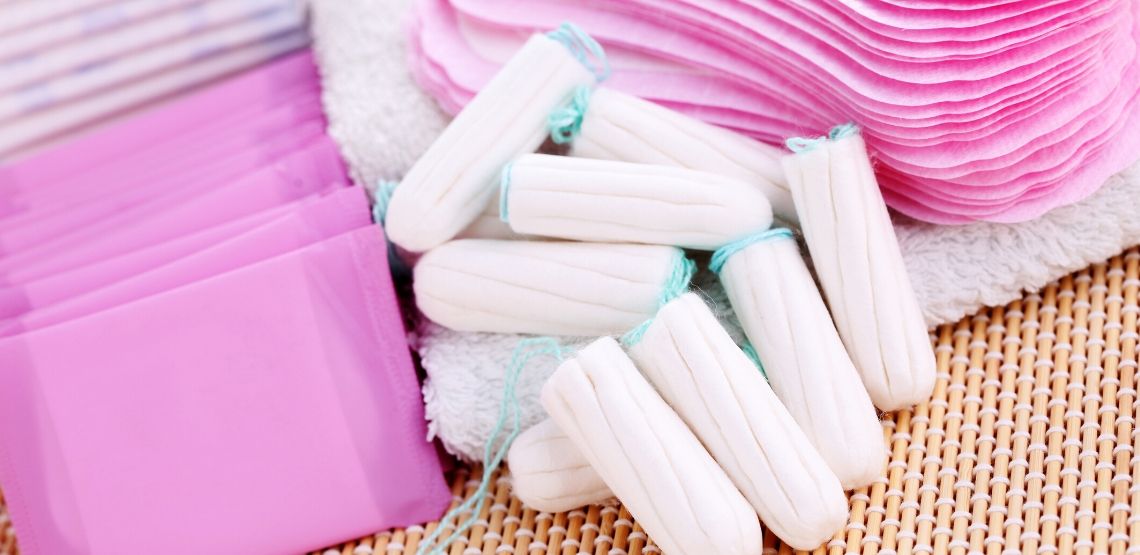Different Types of Feminine Hygiene Products
Every month, women worldwide contend with yet another menstrual cycle. Over her lifespan, she will have about 13 cycles each year for about 40 years. That is a lot of feminine hygiene products being used, which makes it important to know which products suit you best.
External Protection and Internal Protection for Feminine Hygiene Products
There are two types of feminine hygiene products which protect either internally or externally. Internal protection is designed to absorb menstrual flow before it leaves the body and these devices are inserted into the vagina. External protection absorbs menstrual flow after it leaves the body. No matter which type of product you use, always follow the manufacturer’s instructions on how and when to replace your feminine hygiene product.
Types of Internal Protection
Tampons
Tampons are the most common type of internal protection. Tampons are little plugs that you insert into your vagina to absorb menstrual flow and come with a string attached for easy removal. Once inserted, they are held in place by the muscles of your vagina. When placed properly, you cannot feel tampons, which makes swimming or playing sports much more comfortable. Some tampons are made of synthetic materials and chemicals, but you can spend a bit more money to get all cotton tampons.
There is a low risk of toxic shock syndrome (TSS) infections with tampons. To minimize your chances of TSS, change your tampon frequently and switch to pads intermittently at night.
Menstrual Cups
Reusable menstrual cups are an environmentally friendly solution to feminine hygiene products. Unlike tampons, which absorb menstrual blood, menstrual cups collect it. Cups are both safe and easy to use. It looks like a small funnel or bowl and is usually made of rubber or medical grade silicone. These materials enable you to pinch or fold the cup so you can insert it into your vagina where you place it a few inches below the cervix. Depending on your flow, it can be worn up to 12 hours depending on the brand. To reuse, simply remove the cup, drain the contents, wash it and reinsert. Cups usually come in two sizes; the larger cup is recommended for women over 30 who have vaginally delivered a baby.
Cups are not linked to TSS because they do not absorb the blood. This feminine hygiene product is not ideal if you are not sexually active or you have a heavy flow. Cups cost more up front than a box of tampons, but if taken care of, it can last for years (unless you purchase disposable cups). If you have reusable cups, make sure they are properly cleaned and stored when not in use.
Related Search Topics (Ads)
Sea Sponge Tampons
Sea sponge is harvested from the ocean floor, so it contains no synthetic materials. The sponge is naturally bleached with hydrogen peroxide and made available as a tampon option. When dry, the sponge is hard, but once it is dampened, it softens. To insert, you will need to dampen the sponge, squeeze it in your hand to compress it and gently insert into your vagina. Once it is in there, it absorbs menstrual flow like a tampon. It needs to be rinsed every three hours and thoroughly cleaned, dried and stored at the end of each menstrual cycle. With proper care, one sponge lasts about six months. It is delicate, so be careful when you are handling the sponge to avoid ripping it during insertion and removal. If it rips, you will need to throw it away.
Types of External Protection
Pads
Pads are narrow pieces of material that stick to your underwear to absorb your menstrual flow. Pads are designed to funnel fluid into an absorbent core to keep you feeling dry. The absorbent core locks away moisture to minimize leaks and control odour, while a back sheet prevents moisture from leaking out of the bottom of the pad. Pads need to be switched out every few hours, so you want to make sure you have extras on hand.
You can also buy reusable pads. You can rinse and wash them so you do not need to throw them away. Reusable pads are usually constructed with a liner and a liner holder. The liner holder snaps around your underwear to keep it in place. These pads are made of cotton, not plastic, so are less irritating for the user. Reusables are more expensive up front but save you money over time since they last for years. Fabric pads are a good option for those with allergies or sensitive skin.
Period Panties
This is a newer option in the market. Period panties are reusable, absorbable underwear that are designed with extra layers of fabric to absorb menstrual flow without a pad or other feminine hygiene product. You wear them just like normal underwear and they come in various styles from thong to high waist panties. Period panties have a thick crotch built-in which absorbs light to medium flow. These panties are washable, reusable and environmentally friendly. Users say this is a comfortable option that does not stain and absorbs menstrual flow all day. The downside to this option is that they are a more expensive.
How to Pick What Works for You
There’s that old saying “you never know until you try.” Your decision about which products work best for you will be based on what makes you feel the most comfortable and protected. Internal protection is great for active individuals who engage in sports. Reusable options like the menstrual cup, period panties, or reusable pads are ideal for those who want to reduce their impact on the planet. Research products that you are interested in to make an informed purchase decision. There are also some options on this list that contain allergens, like latex, so if you have a sensitivity, be sure to find out what each option is made of.
Ladies, many of you will have a lot of periods in your lifetime, so make it as comfortable as you are able. Using the right product will make a big difference in how you feel about your menstrual cycle.


